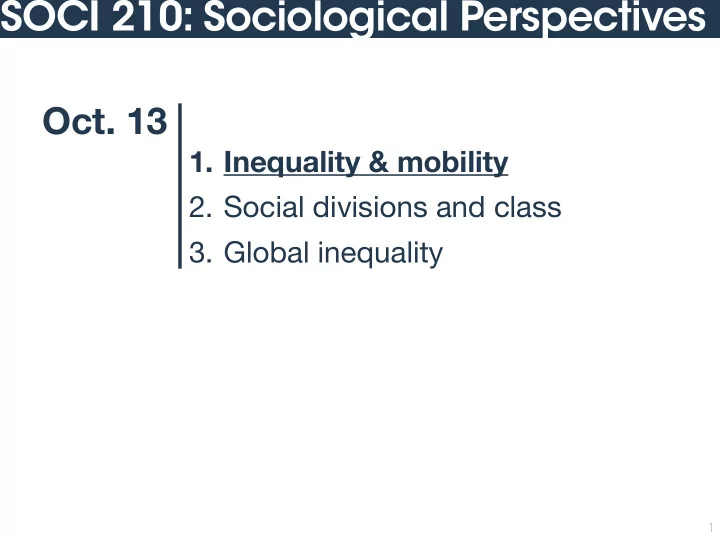

SOCI 210: Sociological Perspectives Oct. 13 1. Inequality & mobility 2. Social divisions and class 3. Global inequality 1
Roadmap 1.Foundations Methods overview Classical (European) social theory 2.The individual in society (bottom-up) Ethnicity, race, and nationality Disability Gender and sexuality Class and culture 3.Populations and publics (top-down) Inequality and stratification Demography Politics and economy Social movements 4.Social systems (middle-out) Interaction Institutional change Organizations and groups Media and technology 2
Roadmap 1.Foundations Methods overview Classical (European) social theory 2.The individual in society (bottom-up) Ethnicity, race, and nationality Disability Gender and sexuality Class and culture 3.Populations and publics (top-down) Inequality and stratification Demography Politics and economy Social movements 4.Social systems (middle-out) Interaction Institutional change Organizations and groups Media and technology 3
Roadmap 1.Foundations Methods overview Classical (European) social theory 2.The individual in society (bottom-up) Ethnicity, race, and nationality Disability Gender and sexuality Class and culture 3.Populations and publics (top-down) Inequality and stratification Demography Politics and economy Social movements 4.Social systems (middle-out) Interaction Institutional change Organizations and groups Media and technology 4
& Inequality Mobility 5
What is inequality? Unequal distribution of resources ⦙ Some people have more than others ⦙ Predictable patterns of inequality Types of resources ⦙ Money! ⦙ But also: power, opportunity, geographic mobility, social capital, legal protections, … Ubiquitous ⦙ Empirically, high levels of inequality are present in virtually every human society 6
Inequality Measuring inequality and poverty ⦙ Present everywhere, but to what degree? ⦙ Multiple dimensions complicate description ⦙ Measurement helps determine both rates of poverty and wealth disparity ⦙ Measurement helps compare across populations and across time 7
Inequality vs. Absolute measures Relative measures ⦙ Define poverty according ⦙ Define poverty relative to to a ‘universal’ baseline what is ‘normal’ in a society ⦙ “Basket of goods”: Calculate the local cost of a ⦙ Calculated in reference to collection of essential society’s median income household items ⦙ E.g. 50% of the median ⦙ “Poverty line”: income Household income used as the official threshold for poverty Paraisopolis and Morumbi neighborhoods in São Paulo 8 Photo: Tuca Vieira
Inequality Gini index (or Gini coe ffi cient) ⦙ Very common measure of inequality ⦙ Ranges from 0–1 (or 0–100) From absolute equality to absolute inequality ⦙ “Relative, not absolute Could have a population with low inequality but widespread poverty, or a population with high inequality and no poverty Gini index (income) Gini Index 40 38 36 Canada 34 32 1980 1990 2000 2010 Year Source: World Bank, Development Research Group. (http://iresearch.worldbank.org/PovcalNet/index.htm). 9
Inequality Gini index (or Gini coe ffi cient) ⦙ Very common measure of inequality ⦙ Ranges from 0–1 (or 0–100) From absolute equality to absolute inequality ⦙ “Relative, not absolute Could have a population with low inequality but widespread poverty, or a population with high inequality and no poverty United Gini index (income) Gini Index States 40 38 36 Canada 34 32 1980 1990 2000 2010 Year Source: World Bank, Development Research Group. (http://iresearch.worldbank.org/PovcalNet/index.htm). 10
Mobility ? + Patterns of inequality ⦙ Wealth is not a random lottery ⦙ Predictable structure to who has more and who has less Inheritance of opportunity ⦙ Empirically, income and wealth are largely predicted by family ⦙ Wealthy people are much more likely to come from wealthy families than poor families, and vice versa Mobility refers to these patterns ⦙ ‘Stickiness’ of who is where in the unequal income distribution ⦙ How hard is it to move up or down in a society’s income distribution? 11
Mobility + 12
Stratification Stratification ⦙ Term to describe patterns of inequality ⦙ Geological metaphor Differences appear categorical Vertical dimension Stratification and Mobility ⦙ People are born into particular strata ⦙ How easy is it to get to a di ff erent stratum? ⦙ Direction matters Upward mobility versus downward mobility 13
Barriers to mobility Why is mobility low? Structural barriers Socialized barriers (external) (internalized) ⦙ Material ⦙ Socialized traits Family wealth, area of Habits, language, skills, residence, … aesthetic, … Highly ⦙ Institutional ⦙ Internalized Access to schools and expectations interrelated clubs, social relationships, … ⦙ Behavioral di ff erences are linked to material context ⦙ E.g. Stanford Marshmallow Experiment 14
Recommend
More recommend